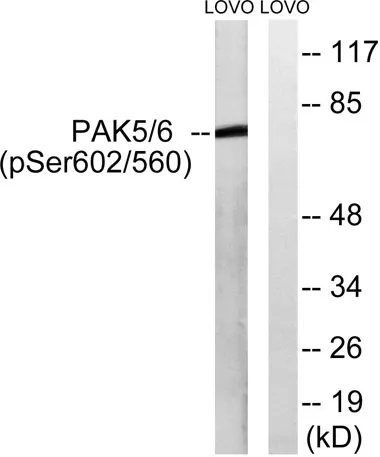PAK5/6 (phospho Ser602/S560) rabbit pAb
CAT:
855-ES6872-01
Size:
50 μL
Price:
Ask
- Availability: 24/48H Stock Items & 2 to 6 Weeks non Stock Items.
- Dry Ice Shipment: No




PAK5/6 (phospho Ser602/S560) rabbit pAb
- Description: The protein encoded by this gene is a member of the PAK family of Ser/Thr protein kinases. PAK family members are known to be effectors of Rac/Cdc42 GTPases, which have been implicated in the regulation of cytoskeletal dynamics, proliferation, and cell survival signaling. This kinase contains a CDC42/Rac1 interactive binding (CRIB) motif, and has been shown to bind CDC42 in the presence of GTP. This kinase is predominantly expressed in brain. It is capable of promoting neurite outgrowth, and thus may play a role in neurite development. This kinase is associated with microtubule networks and induces microtubule stabilization. The subcellular localization of this kinase is tightly regulated during cell cycle progression. Alternatively spliced transcript variants encoding the same protein have been described. [provided by RefSeq, Jul 2008],
- Synonyms: PAK7; KIAA1264; PAK5; Serine/threonine-protein kinase PAK 7; p21-activated kinase 5; PAK-5; p21-activated kinase 7; PAK-7; PAK6; PAK5; Serine/threonine-protein kinase PAK 6; PAK-5; p21-activated kinase 6; PAK-6
- Gene ID: 57144/56924
- UniProt: Q9P286/Q9NQU5
- Cellular Locus: Mitochondrion. Cytoplasm. Nucleus. Shuttles between the nucleus and the mitochondria, and mitochondrial localization is essential for the role in cell survival.
- Host: Rabbit
- Species Reactivity: Human, Mouse
- Immunogen: The antiserum was produced against synthesized peptide derived from human PAK5/6 around the phosphorylation site of Ser602/Ser560. AA range:566-615
- Clonality: Polyclonal
- Validated Applications: WB, ELISA
- Stability: 1 year
- Concentration: 1 mg/mL
- Dilution: Western Blot: 1/500 - 1/2000. ELISA: 1/20000. Not yet tested in other applications.
- Molecular Weight: 75kD
- Storage Conditions: PBS with 0.02% sodium azide and 50% glycerol pH 7.4. Store at -20°C. Avoid repeated freeze-thaw cycles.
